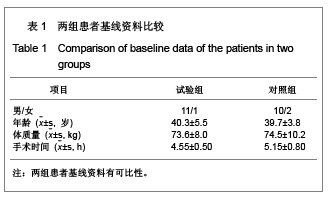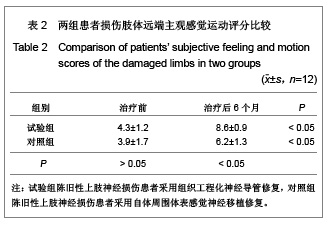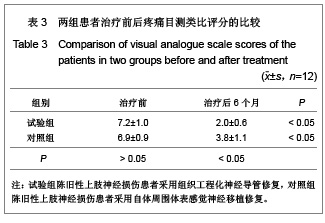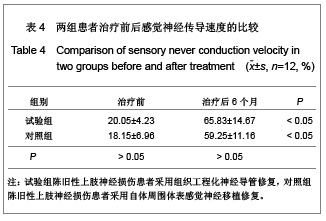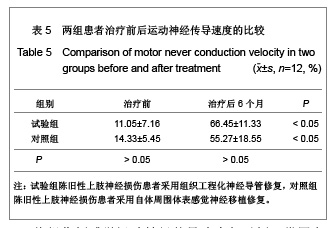| [1] State council of the Peoples’Republic of China.Administrativse Regulation on medical Institution, 1994-09-01. 中华人民共和国国务院.医疗机构管理条例.1994-09-01.[2] McDaniel Jr HE.Tissue engineered collagen nerve guidance channels.In: Stark GB,Horch R,Tanoszos E.Biological matrices and tissue reconstruction. Heidelberg:Springer, 1998:237-242.[3] Sieminski AL,Gooch KJ.Biomaterial-microvasculature interaction. Biomaterials.2000;21(22):2233-2241.[4] Apel PJ,Peng J,Sierpinski P,et al.Peripheral Nerve regeneration using a keratin-Based scaffold:long-term functional and histological outcomes in a mouse model.J Hand Surg Am.2008;33(9):1541-1547.[5] Valmikinathan CM,Tian J,Wang J,et al.Novel nanofibrous spiral scaffolds for neural tissue engineering.J Neural Eng.2008;5(4):422-432.[6] Diao YF,Shang CZ. Zhongguo Zuzhi Gongcheng Yanjiu yu Linchuang Kangfu. 2011;15(34):6424-6427. 刁云峰,商崇智.神经导管生物材料在神经修复中的应用[J].中国组织工程研究与临床康复,2011,15(34):6424-6427.[7] Dahilin LB.Techniques of peripheral nerve repair.Scand J Surg.2008;97(4):310-316.[8] Yu H,Peng J,Sun H,et al.Effect of controlled release nerve growth factor on repairing peripheral nerve defect by acellular nerve graft.Zhongguo Xiu Fu Chong Jian Wai Ke Za Zhi. 2008; 22(11):1373-1377.[9] Krarup C,Archibald SJ,Madison RD.Factors that influence peripheral nerve regeneration:an electrophysiological study of the monkey median nerve.Ann Neurol.2002;51(1):69-81.[10] Wang YH,Dai HL,Li SP.Wuhan Ligong Daxue Xuebao. 2009; 31(12):62-67. 王永红,戴红莲,李世普.神经导管生物材料的研究[J].武汉理工大学学报,2009,31(12):62-67.[11] Ahmed MR,Variamuthu S,Shafluzama M,et al. Microwave irradiated collagen tubes as a better matrix for peripheral nerve regeneration.Brain Res.2005;1046(1-2):55-67.[12] Matsumoto K,Ohnishi K,Kiyotarni T,et al. Peripheral nerve regeneration across an 80-mm gap bridged by a polyglycolic acid (PGA)-collagen tube filled with laminin-coated collagen fibers: a histological and electrophysiological evaluation of regenerated nerves.Brain Res.2000;868(2):315-328.[13] Liu SQ,Li HH,Peng H,et al.Zhonghua Shiyan Waike Zazhi. 2005;22(5):593-594. 刘世清,李浩恒,彭昊,等.新型纤维素导管桥接周围神经缺损的实验研究[J].中华实验外科杂志,2005,22(5):593-594.[14] Weber RA,Breidenbach WC,Brown RE,et al. A randomized prospective study of polyglycolic acid conduits for digital nerve reconstruction in humans.Plast Reconstr Surg. 2000; 106(5):1036-1045.[15] Xie F,Li QF,Gu B,et al.Zhengxing Zaizao Waike Zazhi. 2004; 1(3): 144-146. 谢峰,李青峰,顾彬,等.神经导管修复周围神经损伤的临床应用[J].整形再造外科杂志,2004,1(3):144-146.[16] Zhao W,Zhang ZY,Sun J,et al. Zhongguo Zuzhi Gongcheng Yanjiu yu Linchuang Kangfu. 2009;13(47):9236-9240. 赵文,张志愿,孙坚,等.碳纳米管增强型天然复合材料神经导管修复大鼠副神经缺损[J].中国组织工程研究与临床康复,2009, 13(47):9236-9240.[17] Huang JF,Zheng HY,Li SP,et al.Zhonghua Shouwaike Zazhi. 2009;25(3):154-157. 黄继峰,征华勇,李世普,等.RGD多肽接枝聚复合导管桥接神经缺损的实验研究[J].中华手外科杂志,2009,25(3):154-157.[18] Yang HL. Zhongguo Zuzhi Gongcheng Yanjiu yu Linchuang Kangfu.2010;14(29):5439-5442. 杨华林.神经导管生物材料修复周围神经损伤的动物实验[J].中国组织工程研究与临床康复,2010,14(29):5439-5442.[19] López-Vales R,Navarro X,Shimizu T,et al. Intracellular phospholipase A2 group IVA and group. VIA play important roles in Wallerian degeneration and axon regeneration after peripheral nerve injury.Brain.2008;131(Pt10):2620-2631.[20] Wang RY,Guo YM,Guo Y.Tianjin Zhongyiyao. 2011;28(3): 260-261. 王然芸,郭永明,郭义.周围神经再生和修复的研究进展[J].天津中医药,2011,28(3):260-261.[21] Tan Q.Yixue Yanjiusheng Xuebao. 2011;24(2):113-116. 谭谦.再生医学与组织工程[J].医学研究生学报,2011,24(2):113- 116. |
